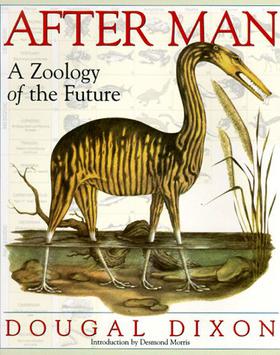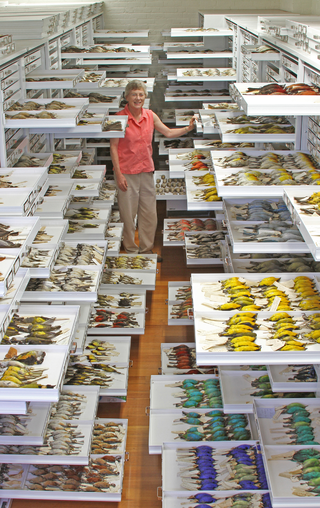
The Natural History Museum in London is a museum that exhibits a vast range of specimens from various segments of natural history. It is one of three major museums on Exhibition Road in South Kensington, the others being the Science Museum and the Victoria and Albert Museum. The Natural History Museum's main frontage, however, is on Cromwell Road.

The Royal Ontario Museum (ROM) is a museum of art, world culture and natural history in Toronto, Ontario, Canada. It is one of the largest museums in North America and the largest in Canada. It attracts more than one million visitors every year, making it the most-visited museum in Canada. It is north of Queen's Park, in the University of Toronto district, with its main entrance on Bloor Street West. Museum subway station is named after it and, since a 2008 renovation, is decorated to resemble the ROM's collection at the platform level; Museum station's northwestern entrance directly serves the museum.

The Field Museum of Natural History (FMNH), also known as The Field Museum, is a natural history museum in Chicago, Illinois, and is one of the largest such museums in the world. The museum is popular for the size and quality of its educational and scientific programs, and its extensive scientific specimen and artifact collections. The permanent exhibitions, which attract up to 2 million visitors annually, include fossils, current cultures from around the world, and interactive programming demonstrating today's urgent conservation needs. The museum is named in honor of its first major benefactor, Marshall Field, the department-store magnate. The museum and its collections originated from the 1893 World's Columbian Exposition and the artifacts displayed at the fair.

The American Museum of Natural History (AMNH) is a natural history museum on the Upper West Side of Manhattan in New York City. Located in Theodore Roosevelt Park, across the street from Central Park, the museum complex comprises 21 interconnected buildings housing 45 permanent exhibition halls, in addition to a planetarium and a library. The museum collections contain about 32 million specimens of plants, animals, fungi, fossils, minerals, rocks, meteorites, human remains, and human cultural artifacts, as well as specialized collections for frozen tissue and genomic and astrophysical data, of which only a small fraction can be displayed at any given time. The museum occupies more than 2,500,000 sq ft (232,258 m2). AMNH has a full-time scientific staff of 225, sponsors over 120 special field expeditions each year, and averages about five million visits annually.

Carl Ethan Akeley was a pioneering American taxidermist, sculptor, biologist, conservationist, inventor, and nature photographer, noted for his contributions to American museums, most notably to the Milwaukee Public Museum, Field Museum of Natural History and the American Museum of Natural History. He is considered the father of modern taxidermy. He was the founder of the AMNH Exhibitions Lab, the interdisciplinary department that fuses scientific research with immersive design.

The Florida Museum of Natural History (FLMNH) is Florida's official state-sponsored and chartered natural history museum. Its main facilities are located at 3215 Hull Road on the campus of the University of Florida in Gainesville.

The New England Aquarium is a nonprofit organization located in Boston, Massachusetts. The species exhibited include harbor and northern fur seals, California sea lions, African and southern rockhopper penguins, giant Pacific octopuses, weedy seadragons, and thousands of saltwater and freshwater fishes. In addition to the main aquarium building, attractions at Central Wharf include the Simons Theatre and the New England Aquarium Whale Watch. More than 1.3 million guests visited the aquarium each year prior to the outbreak of the COVID-19 pandemic.

The Sam Noble Oklahoma Museum of Natural History is the officially designated natural history museum for the State of Oklahoma, located on the campus of the University of Oklahoma. The museum was founded in 1899 by an act of the Oklahoma Territorial Legislature. Its current building was completed in 1999 under the leadership of Michael A. Mares, who was director from 1983-2003 and from 2008-2018. The museum contains more than 10 million objects and specimens in 12 collections. The current building is a 198,000-square-foot facility with almost 50,000 square feet of public space, with five permanent and two temporary galleries and exhibits that provide an in-depth tour of Oklahoma's natural and cultural history. The remainder of the facility is dedicated to housing museum collections, laboratories, libraries, and offices. It is one of the world's largest university-based natural history museums.

The Natural History Museum of Los Angeles County is the largest natural and historical museum in the Western United States. The museum is located in Exposition Park, Los Angeles, next to the California Science Center. Its collections include nearly 35 million specimens and artifacts and cover 4.5 billion years of history. This large collection comprises not only of specimens for exhibition, but also vast research collections housed on and offsite.

After Man: A Zoology of the Future is a 1981 speculative evolution book written by Scottish geologist and paleontologist Dougal Dixon and illustrated by several illustrators including Diz Wallis, John Butler, Brian McIntyre, Philip Hood, Roy Woodard and Gary Marsh. The book features a foreword by Desmond Morris. After Man explores a hypothetical future set 50 million years after extinction of humanity, a time period Dixon dubs the "Posthomic", which is inhabited by animals that have evolved from survivors of a mass extinction succeeding our own time.

The Denver Museum of Nature & Science is a municipal natural history and science museum in Denver, Colorado. It is a resource for informal science education in the Rocky Mountain region. A variety of exhibitions, programs, and activities help museum visitors learn about the natural history of Colorado, Earth, and the universe. The 716,000-square-foot (66,519 m2) building houses more than one million objects in its collections including natural history and anthropological materials, as well as archival and library resources.

The North Carolina Museum of Natural Sciences (NCMNS) is a natural history museum in Raleigh, North Carolina. The museum is the oldest in the state, and the largest natural history museum in the Southeastern United States.

The Museum of Comparative Zoology is a zoology museum located on the grounds of Harvard University in Cambridge, Massachusetts. It is one of three natural-history research museums at Harvard, whose public face is the Harvard Museum of Natural History. Harvard MCZ's collections consist of some 21 million specimens, of which several thousand are on rotating display at the public museum. In July 2021, Gonzalo Giribet, Alexander Agassiz Professor of Zoology at Harvard and Curator of Invertebrate Zoology, was announced as the new director of the museum.

The Museum of the Earth is a natural history museum located in Ithaca, New York. The museum was opened in 2003 as part of the Paleontological Research Institution (PRI), an independent organization pursuing research and education in the history of the Earth and its life. Both PRI and the Museum of the Earth are formally affiliated with Cornell University. The Museum of the Earth is home to Earth science exhibits and science-related art displays with a focus on the concurrent evolution of the Earth and life.

The Iziko South African Museum, formerly the South African Museum, is a South African national museum located in Cape Town. The museum was founded in 1825, the first in the country. It has been on its present site in the Company's Garden since 1897. The museum houses important African zoology, palaeontology, and archaeology collections.
The Age of Reptiles is a 110-foot (34 m) mural depicting the period of ancient history when reptiles were the dominant creatures on the earth, painted by Rudolph Zallinger. The fresco sits in the Yale Peabody Museum in New Haven, Connecticut, and was completed in 1947 after five years of work. The Age of Reptiles was at one time the largest painting in the world, and depicts a span of nearly 350 million years in Earth's history.

The University of Iowa Museum of Natural History is a natural history museum on the University of Iowa campus in Iowa City, Iowa. The museum was founded in 1858 by instruction of the Iowa General Assembly as the Cabinet of Natural History. It is housed within Macbride Hall, located in the Pentacrest area of the university campus. The museum's collections contain around 140,000 objects, including approximately 31,000 birds, eggs, and nests, 5,000 mammal specimens, 41,000 insects, 44,000 other invertebrates, 6,000 archaeological specimens, and historical documents and images from the museum's history. The museum includes several galleries on Iowa's geological and cultural history, biological diversity, and environmental science, spanning four floors. Major research collections include the Kallam Collection of prehistoric stone tools, the Talbot and Jones Bird Collections, the Frank Russell Collection of Inuit and Native Arctic artifacts, and the Philippine Collection of ethnographic materials from the 1904 World's Fair.

A substantial amount of paleontological research has occurred within or conducted by people from the United States. Paleontologists have found that at the start of the Paleozoic era, what is now "North" America was actually in the southern hemisphere. Marine life flourished in the country's many seas. Later the seas were largely replaced by swamps, home to amphibians and early reptiles. When the continents had assembled into Pangaea drier conditions prevailed. The evolutionary precursors to mammals dominated the country until a mass extinction event ended their reign.

The Peabody Museum of Natural History at Yale University is one of the oldest, largest, and most prolific university natural history museums in the world. It was founded by the philanthropist George Peabody in 1866 at the behest of his nephew Othniel Charles Marsh, an early paleontologist. The museum is best known for the Great Hall of Dinosaurs, which includes a mounted juvenile Brontosaurus and the 110-foot-long (34 m) mural The Age of Reptiles. The museum also has permanent exhibits dedicated to human and mammal evolution; wildlife dioramas; Egyptian artifacts; local birds and minerals; and Native Americans of Connecticut.

James Perry Wilson was an American, painter, designer, and architect best known for his natural history dioramas. Active for over 40 years, he is noted for his work with the American Museum of Natural History, the Peabody Museum of Natural History, and the Boston Museum of Science.

























